Picture this: You’re standing at the door of your bedroom. It’s… cozy. That’s the polite word. The walls feel close, the air feels a little still, and the path to your bed is an obstacle course. You know it’s small, but you desperately want it to feel like a sanctuary, not a storage locker you happen to sleep in. The good news? It’s not about square footage. It’s about physics, perception, and a little bit of design magic.
Most of the advice out there just tells you to “buy smaller furniture.” That’s not the answer. The real secret is in understanding how materials interact with light and how your brain perceives space. It’s about making every single object in that room work hard—either by doing two jobs at once or by tricking your eye into seeing something that isn’t there. Forget the noise about “must-have” items and let’s talk about what actually transforms a space from cramped to serene.
Foundational Strategies & Decluttering
Before you buy a single thing, we need to get the bones right. Think of this as preparing a canvas. You wouldn’t paint a masterpiece on a dirty, cluttered surface. These first steps are about clearing the slate and creating a solid foundation, ensuring everything you add later has maximum impact.
1. Prioritize Needs to Maximize Your Usable Space
You know what people always ask me? “How do I fit everything in?” And my answer is always the same: You don’t. A small bedroom isn’t a miniature version of a large one; it’s a completely different kind of space with its own set of rules. The most important rule is that you cannot have it all. You have to decide what the room’s primary job is. Is it for deep, restorative sleep? Is it a place to get dressed and ready for the day? Is it a quiet corner to read? Pick one, maybe two, and be ruthless about everything else.
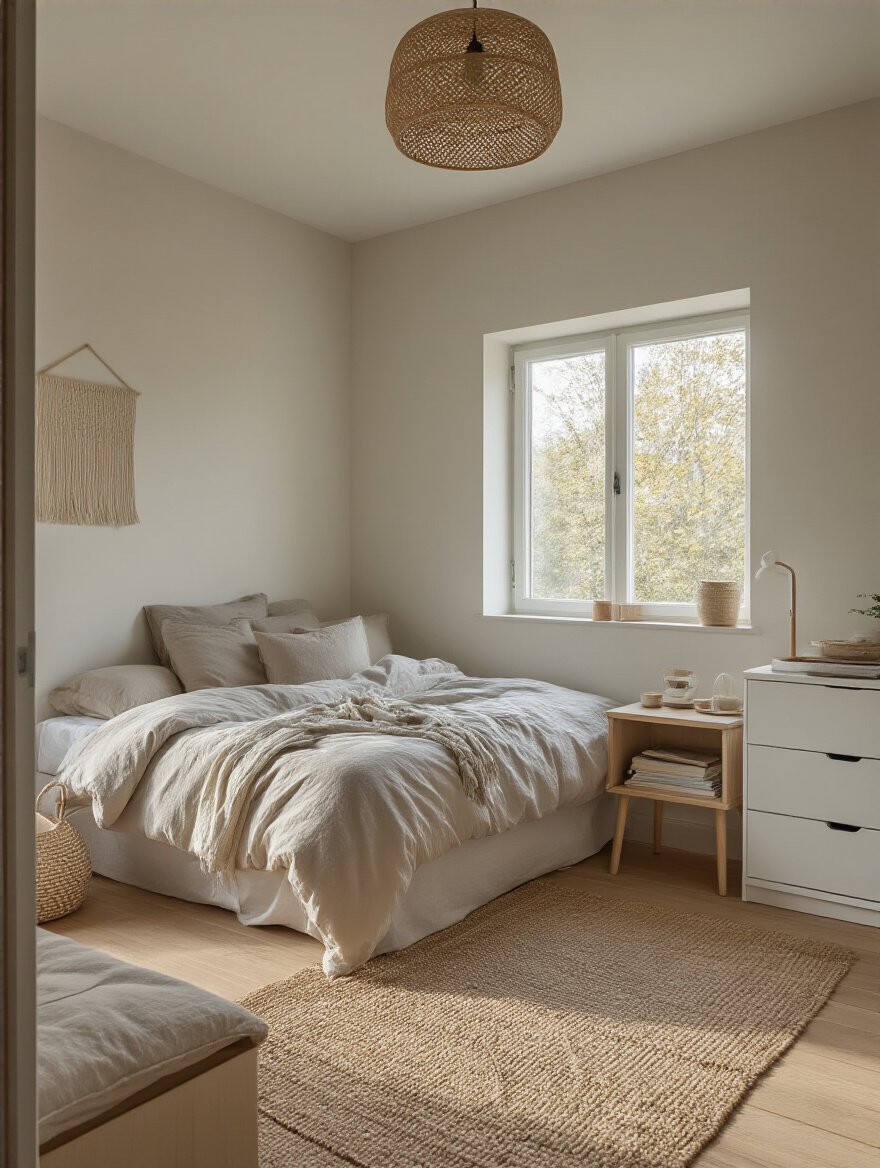
Once you know its job, everything that doesn’t directly serve that function is a freeloader, taking up precious physical and mental space. I once worked with a client who had a huge vanity in her tiny bedroom because she aspired to have this luxurious morning ritual. But in reality, she always did her makeup standing in the better light of the bathroom. The vanity was just an altar to a life she wasn’t living. We replaced it with a sleek, narrow bench, and the room could finally breathe. Ask yourself: What is this room truly for? And then edit accordingly.
Once your purpose is clear, you can start clearing the decks, which is the most satisfying part.
2. Drastically Declutter to Create Instant Openness
Can we talk about the “chairdrobe”? That chair in the corner piled high with clothes that are neither clean nor dirty. It’s the most common symptom of a room that has too much stuff and not enough system. Drastic decluttering isn’t about tidying up; it’s a full-on excavation. You need to physically remove everything that isn’t the bed and essential furniture. Lay it all out in another room and force yourself to justify every single item’s re-entry. If it doesn’t have a specific function or make your heart sing, it doesn’t get to come back in.
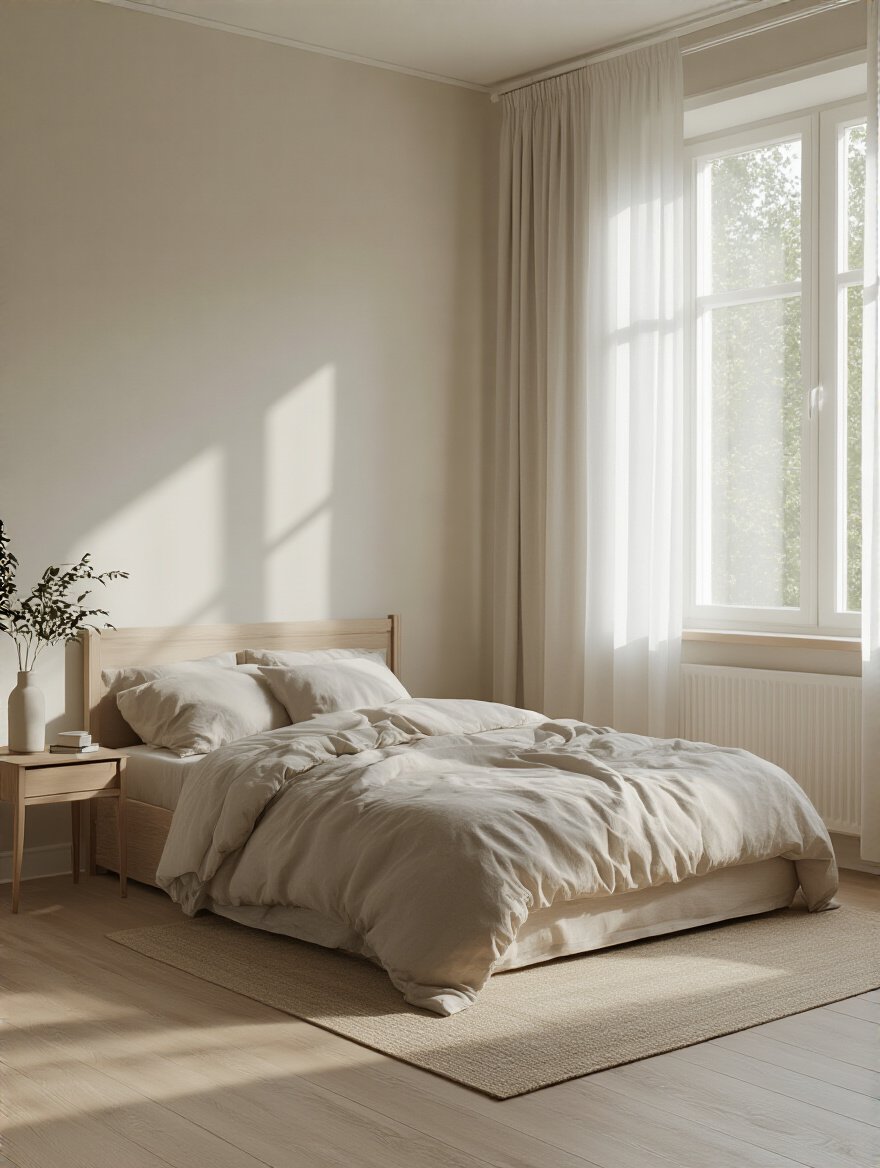
The science here is simple: every object in a room creates visual “noise.” It’s a data point your brain has to process, and in a small space, that adds up to a feeling of chaos and confinement. Clearing surfaces—your floors, your nightstand, your dresser—is like hitting the mute button on that noise. You instantly lower your stress levels and create negative space, which is the interior design equivalent of a deep breath. A clutter-free room doesn’t just look bigger; it feels bigger on a psychological level.
With all that newfound space, now we can get strategic about where the big pieces go.
3. Map Out Optimal Furniture Layout for Flow
I used to think furniture layout was just about making sure you could open the closet door. Then I learned about proxemics—the study of how we use space. The paths we walk through a room are as real as the walls themselves, and in a small bedroom, those paths are critical. A good layout isn’t about cramming furniture against the walls; it’s about creating an intuitive, easy flow from the door to the bed to the window. It should feel effortless.
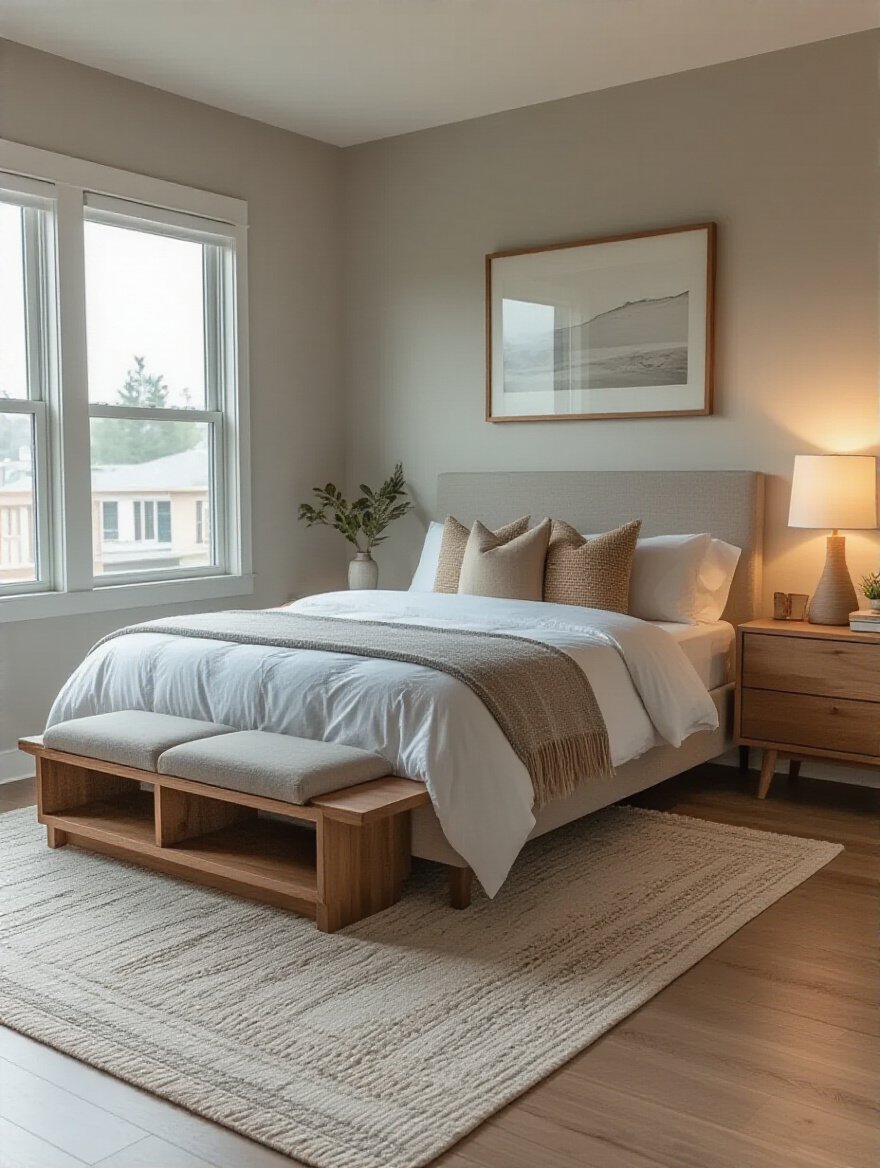
Before you move a single heavy thing, grab a roll of painter’s tape. Measure your furniture and tape out its footprint on the floor. Now, walk the room. Does it feel natural? Do you have to turn sideways to get past the dresser? Can you open the drawers all the way? You need at least two feet, ideally three, for a comfortable walkway. Pushing the bed into a corner can feel like the only option, but sometimes centering it on the longest wall creates more useful space on either side. Live with the tape for a day. It’s a shortcut that will save your back and prevent a layout that looks good on paper but feels terrible in reality.
Now that we know where everything lives, let’s talk about the single most transformative element: color.
4. Choose Light Paint Colors to Visually Expand Walls
Everyone says “paint it white” to make a room feel bigger. They’re not wrong, but they’re not telling you the whole story. The problem is, a pure, stark white in a room with poor natural light can look dingy and clinical. It feels less like a cloud and more like a laboratory. The secret isn’t just “light color,” it’s about a high Light Reflectance Value (LRV) and, crucially, the right undertone and finish.
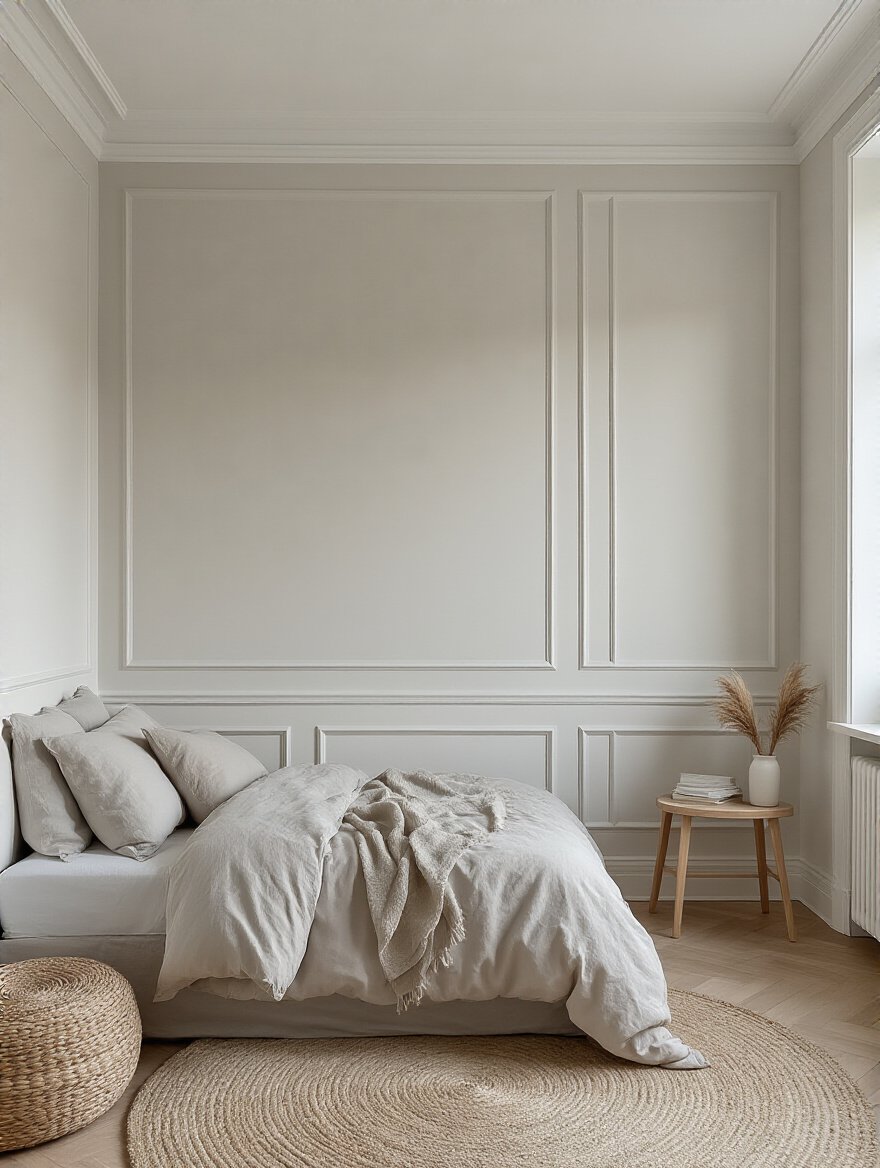
Think of it like this: a high-LRV paint is like a mirror for light, bouncing it around the room. But a flat, matte paint reflects it in a very uniform, almost boring way. An eggshell or satin finish has just enough sheen to give the light some life, making it dance a little. And undertones—a hint of gray, blue, or even a warm blush—prevent the color from feeling sterile. I love using limewash paints in small rooms. Their natural, velvety texture creates subtle variations in color and light, making the walls feel like they have depth and history, effectively pushing them away from you.
As you consider the walls, don’t forget the very first thing you see: the doorway.
5. Optimize Entryways for an Inviting, Spacious Feel
The first three feet inside your bedroom door sets the entire psychological tone for the space. If you have to immediately sidestep a hamper or a pile of shoes, your brain registers “cramped” and “obstacle” before you’ve even fully entered. That first impression is incredibly hard to shake. You must keep this threshold absolutely clear. This is your welcome mat. Make it a good one.

This is a perfect place for a bit of visual trickery. Hang a large, beautiful mirror on the wall opposite or adjacent to the door. As you walk in, it reflects light and space back at you, instantly creating an illusion of depth. Or, if you have a traditional swinging door that eats up wall space, consider swapping it for a pocket or barn door. I did this in my own narrow hallway leading to a bedroom, and freeing up that 9 square feet of “door swing” space was absolutely game-changing. It went from a cramped tunnel to an open passage.
Maximizing Space with Smart Furniture
Furniture in a small room can’t just be pretty. It has to be an acrobat, a contortionist, a master of disguise. Every piece needs to pull its weight, and then some. We’re looking for furniture that floats, folds, hides, and works double duty.
6. Embrace Wall-Mounted Headboards for Floor Savings
The traditional bed frame is a space hog. The headboard legs and the frame itself can steal 4-6 inches of depth from your room, which is an eternity in a small space. A wall-mounted headboard, however, is a brilliant solution. It floats, giving you back that precious floor space and creating a clean, unbroken line that makes vacuuming a dream. But more importantly, it makes the bed feel integrated into the architecture of the room, rather than like a giant object plopped in the middle of it.

From a material science perspective, this is your chance to add a huge swatch of texture without adding bulk. Think about a sleek panel of warm walnut to bring in a natural element, or a channel-tufted velvet headboard to absorb sound and add a layer of plush luxury. Because it’s mounted directly on the wall, you can create the illusion of a grand, custom bed, even if the base is a simple metal frame. It’s a high-impact look with a tiny footprint.
Speaking of that bed frame, let’s look at the goldmine of space sitting right underneath it.
7. Elevate Bed for Hidden Underneath Storage Solutions
The space under your bed is the single most underutilized storage area in most homes. It’s basically a free closet. Getting your bed up off the floor—either with simple risers or by investing in a frame with built-in drawers or a hydraulic lift—is a non-negotiable strategy for a small bedroom. This is where you can hide all the things you don’t need daily: off-season clothes, extra bedding, your collection of embarrassing yearbooks.
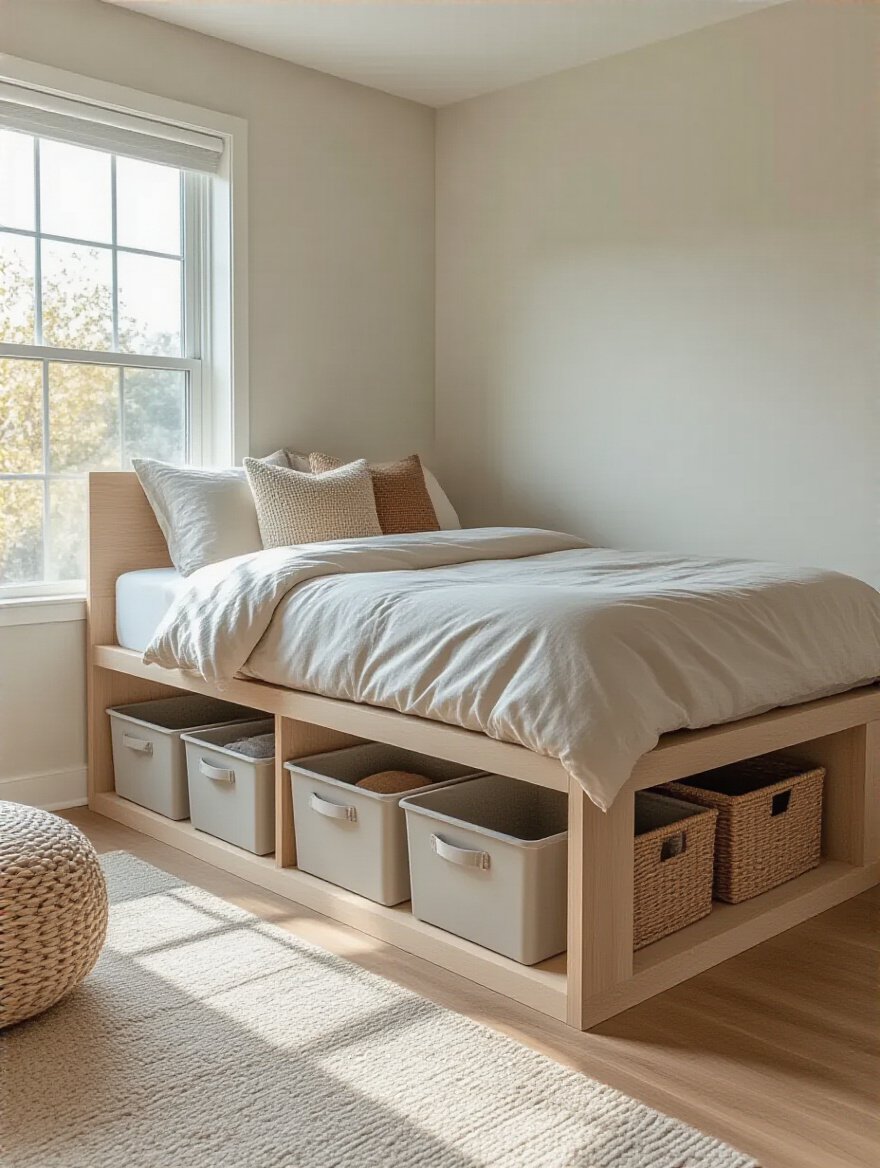
But here’s the key: don’t just shove stuff under there. It’s not a junk drawer. You have to be organized. Use shallow bins, preferably on wheels, or vacuum-seal bags to compress bulky items like duvets. When everything is contained and categorized, it’s not clutter; it’s a “storage system.” The goal is to keep the visible parts of your room serene and uncluttered by making the invisible parts work overtime.
And if you want to take that idea a step further, some beds can do even more.
8. Select multi-functional furniture like Ottoman Beds
An ottoman bed is the undisputed champion of multi-functional furniture. It’s a bed, yes, but its base is a massive, hidden trunk. With a gas-lift mechanism, the entire mattress lifts up to reveal an enormous cavity of storage space. For anyone living in a studio or a home with minimal closet space, this isn’t a piece of furniture; it’s a miracle. You can store your entire winter wardrobe, your luggage, and your backup-supply of toilet paper in there, and no one will ever know.
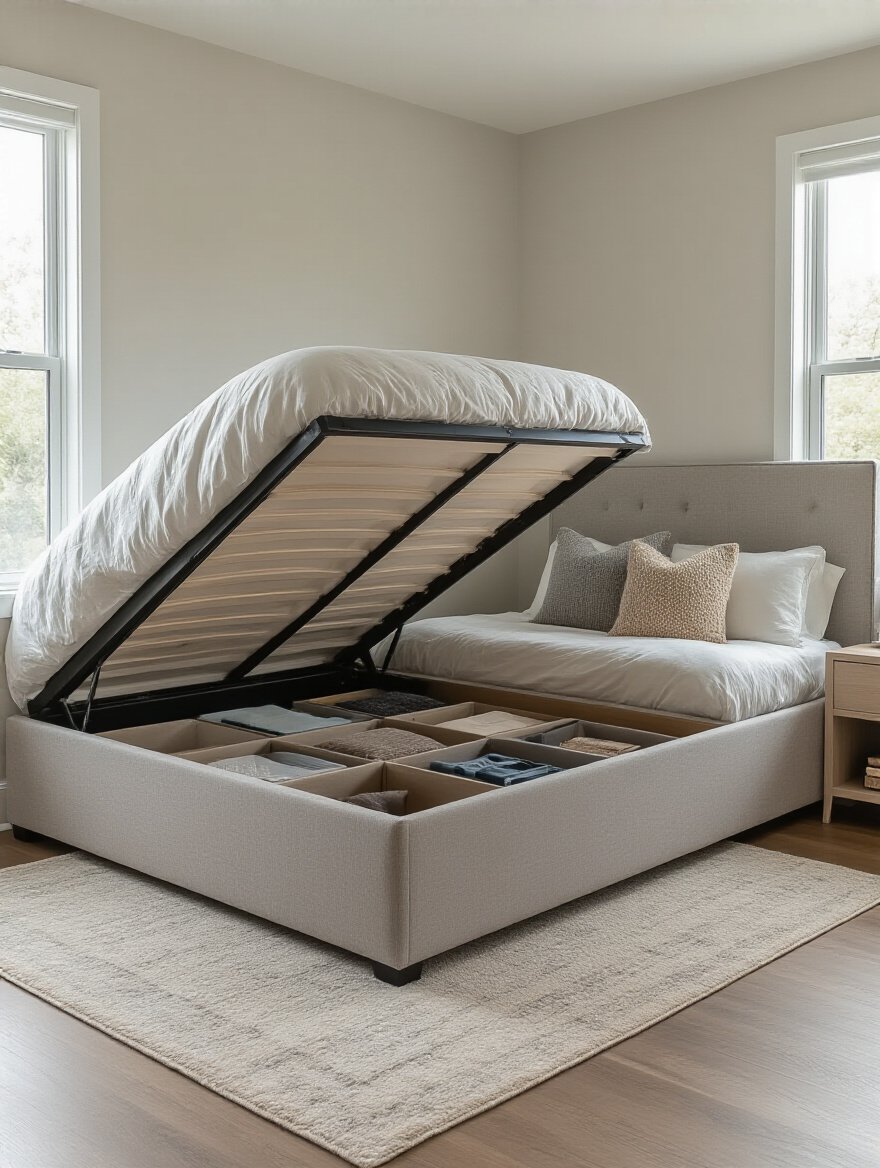
I had a client in a tiny condo who was struggling with a bulky dresser that took up a whole wall. We swapped her standard bed for an ottoman bed and were able to store everything from the dresser inside it. We completely eliminated the dresser, freeing up a massive amount of floor space and visual real estate. The room was transformed overnight from cluttered to streamlined. It’s the ultimate “one in, one out” solution.
When you’re choosing furniture, it’s not just about what it does, but the space it occupies.
9. Invest in Narrow, Tall Dressers for Vertical Gain
In a small room, floor space is sacred. Horizontal space is the enemy. That’s why wide, low dressers—so popular in sprawling suburban bedrooms—are a disaster in compact spaces. They eat up your floor and your wall, limiting where you can place other furniture. The solution is to think vertically. A tall, narrow dresser, often called a “chest of drawers,” gives you the same amount of storage (or more) while taking up half the footprint.
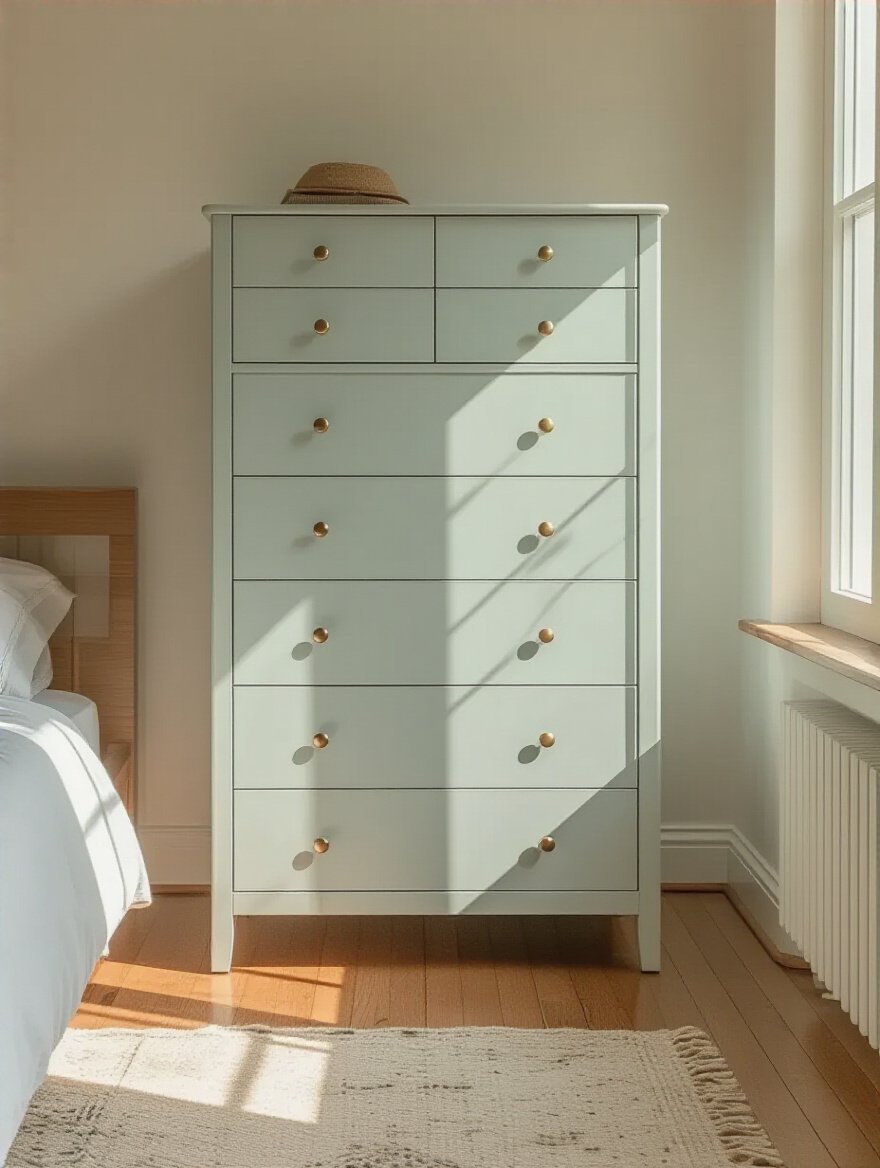
This simple switch has a powerful psychological effect. It draws the eye upward, creating an illusion of height and making your ceilings feel taller. It forces you to take advantage of the vertical plane, which is often completely ignored. Just remember the one non-negotiable rule: you must anchor it securely to the wall. A tall, heavy piece of furniture is a serious safety hazard if it’s not properly secured.
That same vertical logic applies to those awkward, empty corners of the room.
10. Utilize Corner Shelving Units to Boost Storage
Corners are the Bermuda Triangle of most rooms—dead zones where nothing really happens. But in a small bedroom, they’re a massive opportunity. A well-placed corner shelving unit transforms that wasted space into a powerhouse of storage and display. Whether it’s a freestanding tower or a set of floating shelves, you’re claiming vertical real estate that was otherwise doing nothing.
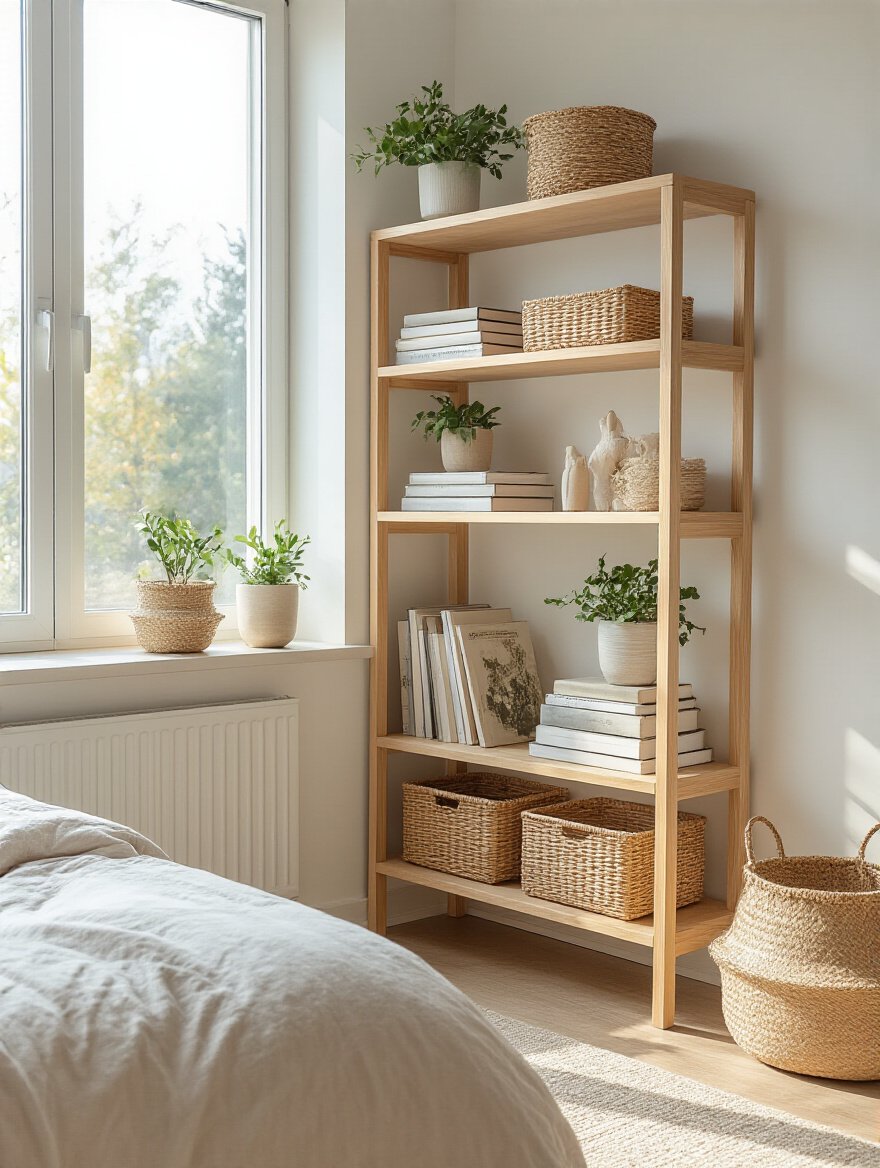
This is the perfect spot for things you want to see but don’t want cluttering up your main surfaces—a few beloved books, a beautiful plant, or a collection of small objects. It adds a layer of personality and depth to the room without encroaching on your precious walking paths. By activating the corners, you make the entire room feel more cohesive and intentionally designed, tricking the eye into seeing the space as fully utilized and therefore, larger.
Just as shelves can reclaim unused space, so can your desk—if you choose the right one.
11. Opt for Fold-Down or Floating Desk Alternatives
Trying to cram a traditional desk into a small bedroom is often a recipe for disaster. It becomes a permanent, bulky obstacle. A fold-down or floating desk, on the other hand, gives you a functional workspace when you need it and disappears when you don’t. A floating desk is essentially a sturdy shelf, which keeps the floor completely clear, creating that airy, open feeling we’re chasing. A fold-down (or “Murphy”) desk is even better—it tucks away completely, giving you back every inch of floor space.
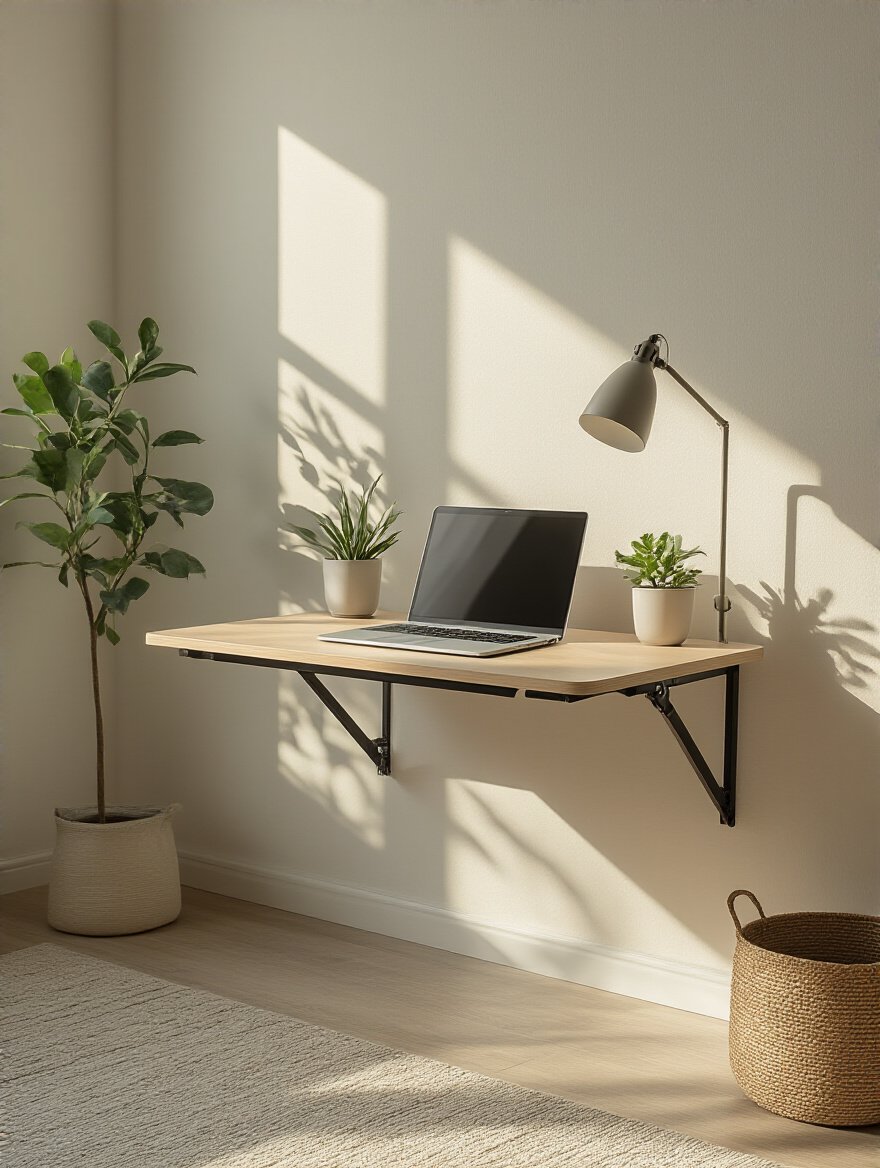
This is about creating a room that can transform its function on a dime. By day, it’s a home office; by night, it’s a serene place to sleep. A friend of mine installed a slim floating desk under her bedroom window. It’s just deep enough for her laptop and a cup of coffee. When she’s not working, it holds a vase of flowers and looks like an intentional decorative shelf. It’s all about that double-duty mindset.
For a truly seamless look, you can take this concept one step further and build storage right into the walls.
12. Integrate Built-In Shelving to Seamlessly Blend Storage
Built-in shelving is the ultimate luxury in a small space. By recessing storage into the walls—flanking a bed, surrounding a window, or filling an awkward alcove—you create a completely seamless, custom look. It feels like it’s part of the room’s architecture, not furniture that’s been added in. This is the single most effective way to maximize storage while minimizing visual bulk.
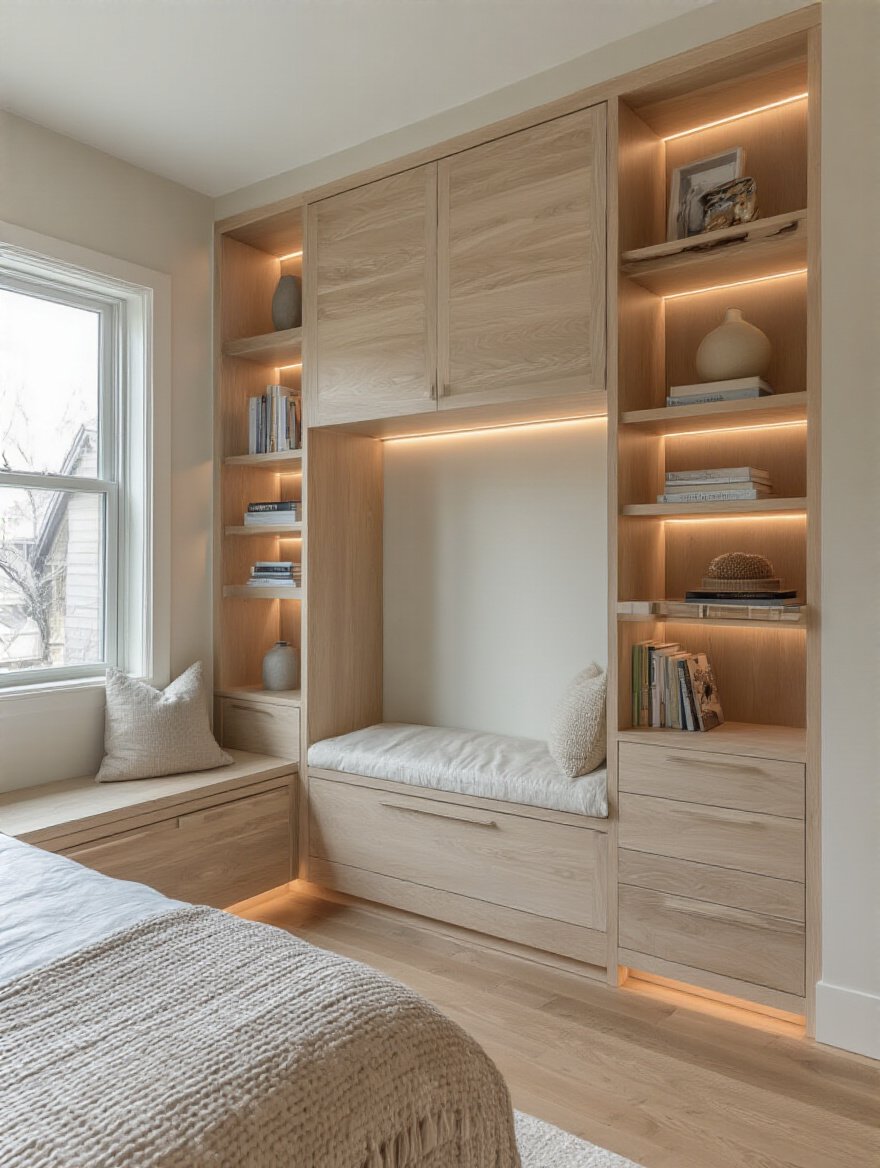
Think about the classic image of built-in shelves around a window, with a cozy window seat nestled in between. You’ve just added seating, storage, and a beautiful focal point without taking up a single extra inch of floor space. While it’s a bigger investment, the payoff is enormous, not just in functionality but in the perceived value of your home. It communicates a level of thoughtfulness and custom design that freestanding furniture just can’t match.
But what if you can’t build into the walls? You can still make your furniture disappear.
13. Choose See-Through Furniture to Reduce Visual Weight
This is one of my favorite tricks because it’s pure material science magic. Furniture made from clear acrylic or glass is what I call “ghost furniture.” It’s there, it’s completely functional, but your eye slides right through it. A clear acrylic waterfall desk or a set of glass nesting tables takes up zero visual space. They allow light to pass through and don’t interrupt the sightline to the wall or the floor beyond, making the room feel profoundly larger.

People worry it will feel cold, but that’s where material pairing comes in. The key is to balance the smooth, hard surface of the acrylic with something soft and tactile. An acrylic C-table next to a plush velvet armchair, or a glass console table over a deep-pile wool rug. This contrast is what creates a rich, sensory experience. You get the space-expanding benefit of transparency combined with the warmth and comfort of texture.
Creating Visual Depth & Light
Now we’re moving into the realm of pure illusion. This section is all about manipulating light and shadow, pattern and reflection, to fool the eye and the brain. This is where you can make an 8×10 room feel like a 12×14.
14. Place Large Mirrors to Amplify Light and Space
A big mirror is not just for checking your reflection; it’s a secret window. Placing a large, floor-length mirror opposite a window is the oldest and most effective trick in the book for a reason. It literally doubles the amount of light and the sense of space in that area. It reflects the view, bringing the outdoors in and breaking down the feeling of being in a box.

But don’t just stop there. Think about the reflective properties of other surfaces. A mirrored closet door can make a whole wall disappear. A dresser with a mirrored finish feels glamorous and light. The key is to be intentional about what you are reflecting. A mirror will amplify whatever is in front of it. If it’s reflecting a cluttered corner, you’re just doubling your clutter. If it’s reflecting a beautiful window or a clean, open wall, you’re doubling your space.
Just as mirrors manipulate light, so do your light fixtures.
15. Install Wall-Mounted Sconces or Pendant Lights
Table lamps are greedy. They eat up the entire surface of your nightstand, leaving no room for a book, a glass of water, or your phone. Reclaim that valuable real estate by moving your lighting to the walls or the ceiling. Wall-mounted sconces—especially swing-arm models you can adjust for reading—are a game-changer. They provide targeted light right where you need it without taking up any surface space.
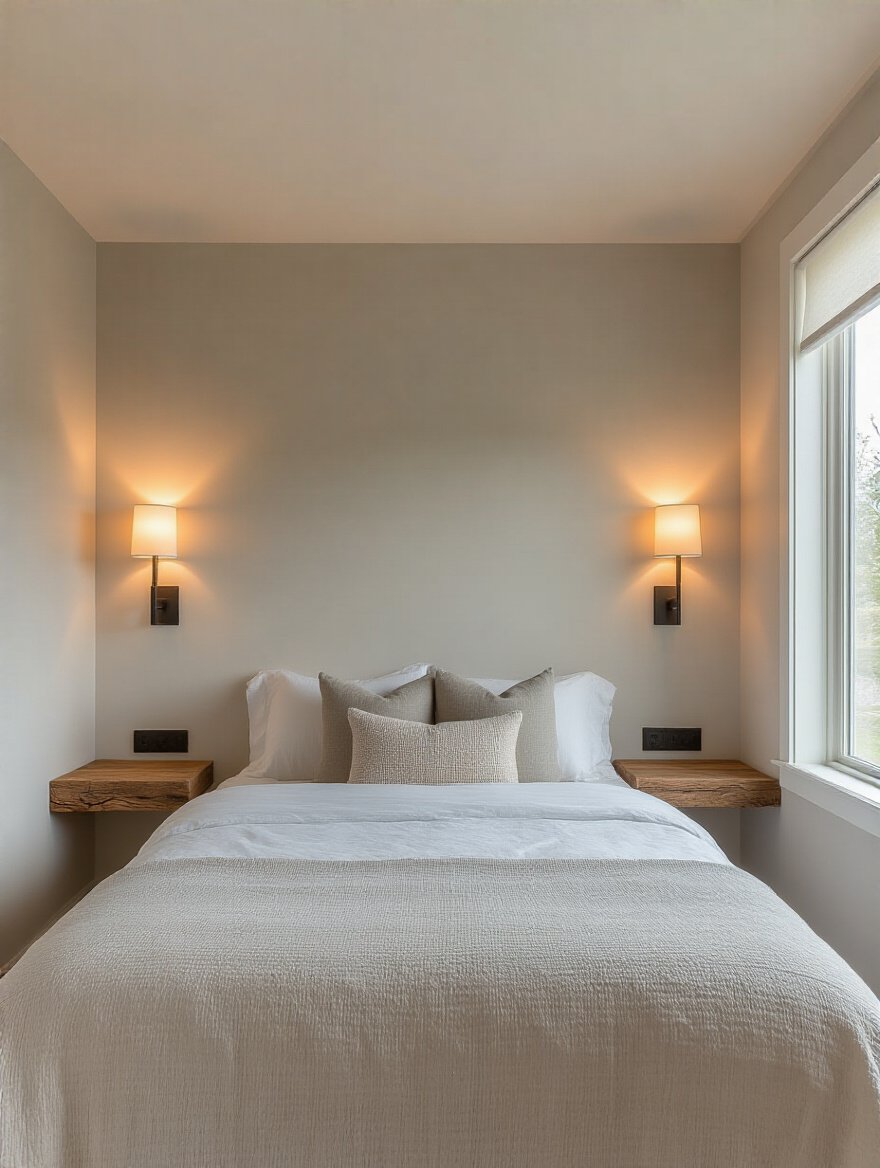
Pendant lights are another fantastic option. A pair of small, elegant pendants hanging on either side of the bed adds a touch of drama and draws the eye upward, emphasizing the room’s verticality. This is a powerful psychological cue that makes the room feel taller and grander. Hardwiring them provides the cleanest look, but there are plenty of beautiful plug-in options that give you the same effect with less commitment.
That same principle of lifting the eye applies to your windows, too.
16. Select Lightweight Curtains to Allow Natural Light
Heavy, dark, puddled drapes belong in a drafty castle, not a small bedroom. They are light-sucking black holes that visually shrink your walls. In a small space, light is your most precious commodity. You want to invite as much of it in as possible. Switch to lightweight, breezy fabrics like linen, voile, or sheer cotton. They filter the light beautifully, creating a soft, ethereal glow while still offering a layer of privacy.

Here’s the pro move: hang your curtain rod as high and wide as possible. Mount the rod 6-12 inches above the window frame and extend it 10-12 inches on either side. Let the panels just kiss the floor. This technique makes your windows look enormous and your ceilings feel sky-high. It’s a simple framing trick that dramatically alters the perceived scale of the room.
We can also manipulate scale and direction with patterns.
17. Use Striped Patterns to Elongate Room Dimensions
Stripes are a powerful tool for optical illusion. Your eye will naturally follow a line, and you can use that to your advantage to reshape your room. Want your low ceilings to feel taller? Use vertical stripes. A feature wall behind the bed with a subtle, tone-on-tone vertical stripe wallpaper can work wonders. Or, even easier, choose curtains with a strong vertical pattern.
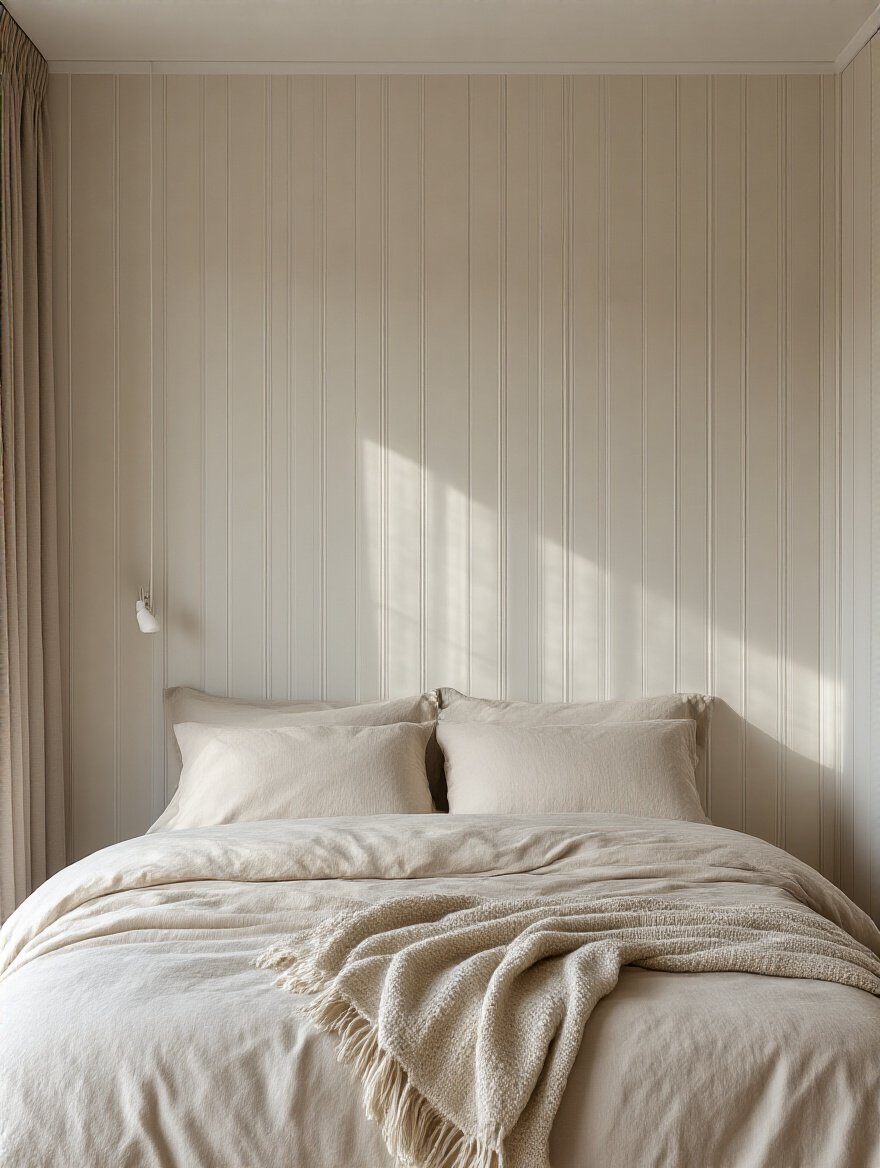
Conversely, if your room is narrow and feels like a hallway, you can use horizontal stripes to make it feel wider. A striped rug running the width of the room can visually push the walls apart. The key is subtlety. You don’t want your room to look like a circus tent. Choose stripes with low contrast or in a limited color palette. A little bit goes a long way.
The ultimate way to create visual space, however, is simply to have less stuff.
18. Employ Minimalist Decor to Avoid Visual Clutter
I know “minimalism” can sound cold or sterile, but that’s a misunderstanding of the concept. True minimalism isn’t about getting rid of everything; it’s about being incredibly intentional about what you keep. It’s a “fewer, but better” philosophy. Every single object in your room should be either beautiful, useful, or both. When you curate your space this way, the room suddenly feels calm and quiet.

This goes back to the idea of visual noise. A minimalist approach is the ultimate way to reduce that cognitive load. With fewer objects vying for your attention, the ones that remain have more impact. A single, beautiful piece of art on a wall makes a much stronger statement than ten smaller pieces. Focus on clean lines, a limited color palette, and a rich variety of textures—like a chunky knit blanket, a smooth wooden bowl, and a soft linen headboard—to create warmth and interest without creating clutter.
Clever Storage & Personalizing Touches
We’ve covered the big moves. Now it’s time for the finishing touches—the clever, small-scale solutions and personal details that make a room functional, beautiful, and uniquely yours.
19. Add Floating Shelves for Display and Organization
Floating shelves are your best friend for getting things up off the floor and onto the walls. They have a clean, minimal profile because their mounting hardware is hidden, which makes them feel much lighter and less intrusive than traditional bookshelves. They’re perfect for the space above a desk, over your headboard, or in an awkward nook that can’t fit a piece of furniture.
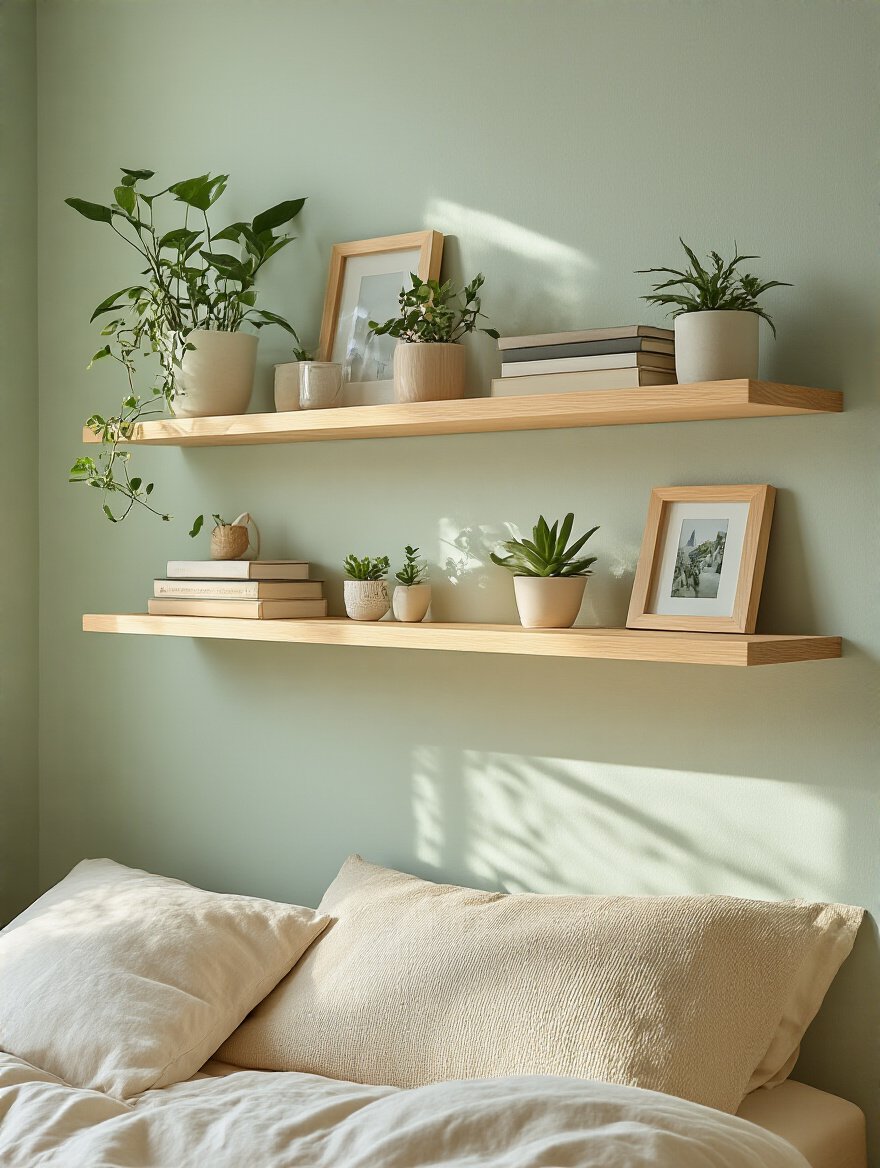
Use them to display a few curated objects that bring you joy—plants, framed photos, special trinkets. But also use them for function. A shallow floating shelf can be a perfect stand-in for a bedside table in a tight spot, holding just a small lamp and your phone. By utilizing this vertical space, you keep your surfaces clear and your room feeling open.
We’ve talked about under the bed, but let’s get specific about how to organize it.
20. Utilize Under-Bed Baskets for Discreet Storage
Under-bed storage is brilliant, but only if you can actually access it. Shoving loose items under there creates a dust-bunny-filled abyss. The solution is to use containers, specifically baskets. Baskets made of natural woven materials like wicker or seagrass add a wonderful layer of texture and warmth to the room, even if they’re mostly hidden. They feel much softer and more organic than plastic bins.
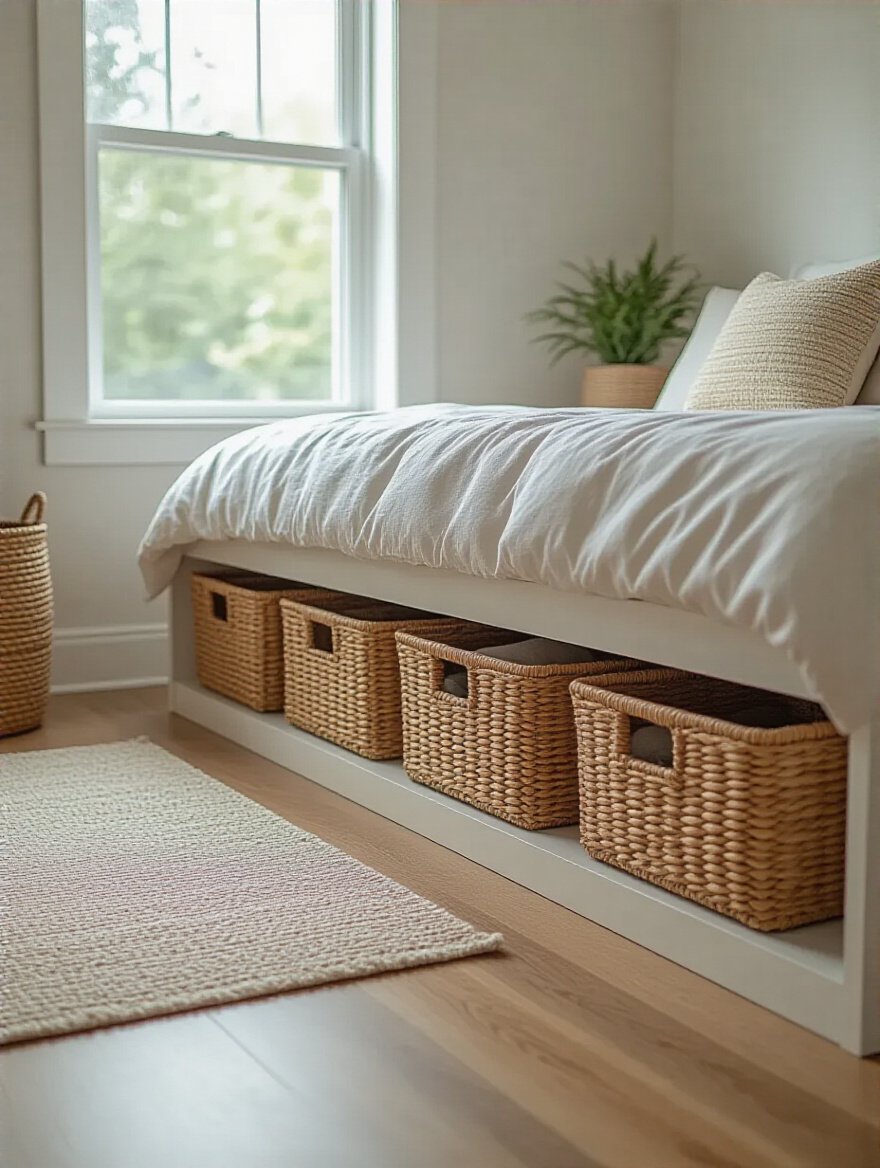
Choose baskets that are the right height for your bed frame and, if possible, have lids to keep dust out. I love using long, shallow baskets on wheels; they slide out effortlessly. This is the perfect home for extra throw blankets, seasonal shoes, or gym clothes. It keeps everything contained, organized, and out of sight, which is the trifecta for small-space living.
And what about the most important storage space of all? The closet.
21. Maximize Closet Storage with Organizers and Rods
Most closets are tragically inefficient. They come with a single rod and a high shelf, which leaves a vast amount of wasted space. You can easily double, or even triple, your closet’s capacity with a few simple additions. The first move is to add a second rod. Most clothing, like shirts, skirts, and folded pants, doesn’t need the full vertical drop. Installing a second rod halfway down instantly doubles your hanging space.

Next, get a set of slim, velvet hangers. These are not a gimmick. They are significantly thinner than plastic or wood hangers and have a non-slip texture that keeps clothes in place. You can fit so much more on the rod. Finally, use the vertical space with hanging organizers for shoes or sweaters, and add clear bins or drawers on the floor for smaller items. An organized closet means less clutter in your bedroom, period.
Finally, let’s bring some life into the space.
22. Introduce Small Plants for Natural, Airy Ambiance
A small room can sometimes feel stale or static. The quickest way to inject life, energy, and a sense of freshness is with plants. You don’t need a giant fiddle-leaf fig. A few small, well-chosen plants can completely change the atmosphere. From a design perspective, they add an organic shape that softens the hard lines and angles of furniture. Psychologically, the presence of living things is inherently calming and connects us to nature.

Use that vertical space we’ve been talking about! A hanging Pothos in a corner draws the eye up. A tiny succulent on a floating shelf adds a pop of color and texture. A snake plant is nearly indestructible and has a great, architectural shape. Plants literally purify the air, but they also purify the vibe of a room, making it feel healthier, happier, and more alive.
Conclusion
So there you have it. Making a small bedroom feel spacious and serene isn’t about waving a magic wand. It’s about a series of deliberate, intelligent choices. It’s understanding that a tall dresser is better than a wide one, that a mirror is a light source, that see-through furniture is your secret weapon, and that the space under your bed is a hidden treasure chest. It’s a blend of practical physics and artful illusion.
Start small. Pick one thing from this list. Swap out your bulky lamps for wall sconces, or finally tackle that closet organization. With every change, you’re not just making your room look better; you’re making it work better for you. You’re creating a calm, functional, beautiful sanctuary where you can truly rest and recharge. Your dream bedroom isn’t a fantasy—it’s just waiting for a smart plan.






